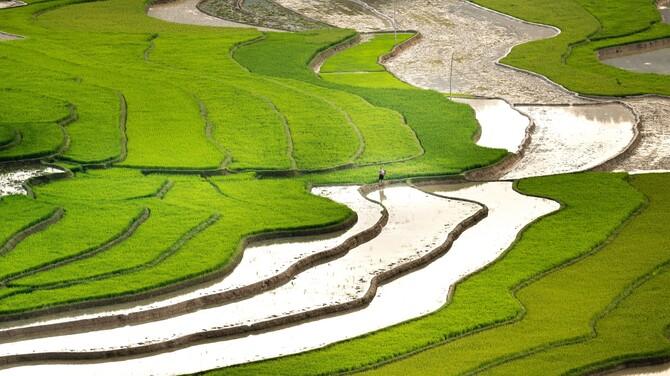What is Terrace Farming? - KhetiGaadi

Terrace farming is an agricultural method where stepped or flat platforms are created on slopes or hillsides to cultivate crops. By constructing terraces, the steep land is transformed into a series of leveled surfaces, preventing soil erosion and allowing efficient water management. This technique maximizes land use, conserves water, and promotes sustainable farming in areas with challenging terrains. Terrace Farming is practised in hilly regions worldwide, including countries like India, China, and Peru.
Terrace Farming in India
Terrace farming has long been practiced in India, particularly in hilly regions like Uttarakhand, Himachal Pradesh, and the Northeast. With limited flat land, farmers ingeniously construct terraces on slopes, creating leveled platforms for cultivation. These terraces prevent soil erosion by controlling water runoff and help conserve precious topsoil. Terrace farming optimizes water management, as the leveled surfaces facilitate efficient irrigation and water distribution. It also promotes agricultural diversification, enabling farmers to grow various crops on separate terraces. This sustainable farming practice in India harnesses the potential of challenging terrains, ensuring food security and maximizing agricultural productivity. Terrace farming in India combines traditional agricultural techniques with modern equipment like a tractor for efficient cultivation on stepped platforms.
Terraces meaning in hindi
तराइयाँ, हिंदी में "terraces" का अर्थ होता है। यह शब्द पहाड़ी या मड़हट्ट जैसे अवकारी क्षेत्रों पर बनाए गए समतल पट्टियों को दर्शाता है। ये पट्टियाँ मुख्यतः किसानों द्वारा खेती के लिए उपयोग होती हैं। तराइयाँ सामरिक पुरों द्वारा या धारों द्वारा निर्मित की जाती हैं और उन्हें खेती के लिए स्थानीय मानव और पशुओं के उपयोग के लिए प्रयोग किया जाता है। तराइयों का निर्माण करके, भूमि का उपयोग कार्यक्षेत्र के रूप में बढ़ाया जाता है, जो खेती की उत्पादकता में सुधार करता है और मृदा को धारण करने में मदद करता है।
What is terrace cultivation?
Terrace cultivation is the method of creating leveled platforms on slopes or hillsides for farming. It prevents soil erosion, optimizes land use in hilly regions, and enables cultivation on steep terrains. This practice promotes sustainable agriculture by conserving soil, enhancing water management, and increasing agricultural productivity.
What is Contour ploughing?
Contour ploughing is an agricultural technique where furrows are ploughed along the natural contours or contour lines of the land. Contour ploughing is also known as contouring farming and contour cultivation. This helps to reduce soil erosion by slowing down water runoff and preventing the formation of gullies. It is an effective method for conserving soil and maintaining its fertility for sustainable farming.
What is strip cropping?
Strip cropping or strip farming is an agricultural practice where different crops are planted in alternating strips or bands across a field. This technique helps to minimize soil erosion by creating barriers that reduce the speed of water runoff. Strip cropping also enhances soil fertility, improves water infiltration, and promotes biodiversity in farming systems.
What is Step Farming?
Step farming is also known as step terrace farming or step cultivation. In this method of agricultural practices crops are cultivated on a series of stepped platforms or terraces. It allows farmers to utilize hilly or sloping terrains efficiently. By creating leveled steps, step farming prevents soil erosion, optimizes water usage, and enhances crop productivity in challenging landscapes.
Benefits of Terrace Farming
-
Terrace farming prevents soil erosion by controlling water runoff and retaining topsoil.
-
It optimizes land utilization in hilly regions, making agriculture possible in challenging terrains.
-
Terrace farming promotes efficient water management and conserves valuable water resources.
-
It allows for diversified crop cultivation, reducing the risk of crop failure and enhancing resilience.
-
Terrace farming supports sustainable agriculture practices by reducing environmental degradation and promoting soil health.
-
It contributes to food security by increasing agricultural productivity in areas with limited flat land.
-
Terrace farming helps preserve traditional farming practices and cultural heritage in mountainous regions.
-
It provides employment opportunities and income generation for local communities engaged in agricultural activities.
Which crops thrive in terrace farming?
The choice of crops in terrace farming depends on various factors such as climate, soil type, market demand, and local agricultural practices. However, certain crops are commonly grown in terrace farming due to their adaptability to hilly terrains and suitability for terrace cultivation techniques. Some popular crops in terrace farming include:
Rice: Rice is a staple crop grown in terraced paddy fields in many parts of Asia, including India, China, and Southeast Asian countries.
Herbs and Medicinal Plants: Some terrace farmers cultivate herbs and medicinal plants like lavender, rosemary, mint, and aloe vera, which have high market demand for culinary, cosmetic, or medicinal purposes.
Wheat: Wheat is a widely cultivated cereal crop suitable for terrace farming, particularly in regions with cooler climates.
Maize: Maize is a versatile crop that can be cultivated on terraces, providing grains for human consumption or animal feed.
Fruits: Depending on the local climate and conditions, terrace farming can include fruit crops such as citrus fruits, strawberries, apples, and peaches.
Vegetables: Various vegetables like tomatoes, cucumbers, beans, and leafy greens can be grown on terraces, offering fresh produce and marketable crops.
Visit KhetiGaadi for more information about Types of farming, Tractor, Tractor price etc.
- Art
- Causes
- Crafts
- Dance
- Drinks
- Film
- Fitness
- Food
- Giochi
- Gardening
- Health
- Home
- Literature
- Music
- Networking
- Altre informazioni
- Party
- Religion
- Shopping
- Sports
- Theater
- Wellness




